The fourth episode in our blog series “Memories from the Life of Walter Frankenstein”
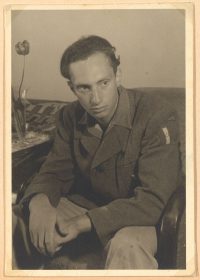
Walter Frankenstein during his time in the kibbutz, Greifenberg, around December 1945–May 1946; Jewish Museum Berlin, gift of Leonie and Walter Frankenstein
What were they to do now? Nothing was left of the Frankensteins’ old life. Their relatives and friends had been murdered, including Walter and Leonie’s mothers. All of Europe lay in ruins.
The first step in the Frankensteins’ new life was a simple administrative act: they registered with the Jewish Community of Berlin and were assigned an apartment. However, due to the bad supply situation, they were advised to leave Berlin as soon as possible. Nevertheless, they decided to spend the summer in Berlin. Walter volunteered as a manager for the Neukölln Leisure Games. At the same time, he made contact with the Jewish Brigade. Over the course of the war, the British Mandate government had drastically reduced the channels for legally entering Palestine. That meant that for the roughly 250,000 displaced persons ( DPs) in camps in western Europe, illegal entry was often the only way to reach Palestine. Walter managed to arrange an opportunity for legal emigration for Leonie and the children through the members of the Jewish Brigade. In return, he promised to smuggle young Jews southward through Germany for the Brigade. Their destinations were harbors on the Mediterranean where underground Jewish organizations prepared ships for their illegal entry into Palestine.
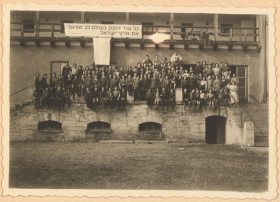
Group picture of kibbutz residents, Greifenberg, around 1946; Jewish Museum Berlin, gift of Leonie and Walter Frankenstein
In mid-November 1945, Leonie left Berlin with her two sons and headed for Palestine. Four weeks later, the Jewish Brigade sent Walter to Greifenberg on Lake Ammer, via Munich and DP Camp Landsberg. A sort of kibbutz had been established there in a former school for regional leaders of the League of German Girls (Bund Deutscher Mädel) Young men and women who had survived the concentration camps, as well as partisans were supposed to be psychologically rehabilitated there and prepared for emigration. A group picture of the residents makes the kibbutz’s principles clear. The men and women are posed under a banner with a quote from a song by Pooa Grinshpon, which reads: “As long as the heart of Israel [meaning the Israelites] is still beating [somewhere] in the world—the Land of Israel!”
It is evident how pronounced the solidarity of the residents with the Zionist movement was at this point in time, as well as their will to emigrate to Palestine and their willingness to found an Israeli state. Walter—who taught jujutsu in the camp, managed the kitchen, and organized the smuggling of people over the border—was no exception. In a portrait from his time in Greifenberg, he posed with a jacket bearing the insignia of the Jewish Brigade.
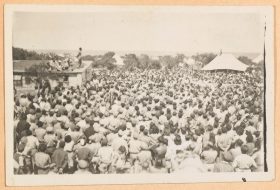
Prisoners demonstrating in an internment camp, near Famagusta, May 1947; Jewish Museum Berlin, gift of Leonie and Walter Frankenstein
Although Walter had been assured that he could follow Leonie and the children to Palestine within six weeks, months had passed. In May 1946, he finally traveled to La Ciotat, near Marseille. He was supposed to ensure that the passengers of the ship Latrun had food and water on their illegal entry voyage. The Latrun set out for Haifa on October 19, 1946, with approximately 1,248 people on board the ship originally intended for 75 passengers. According to his own statements, during the crossing Walter smoked 140 cigarettes daily and hardly slept for seven days. Even if it isn’t absolutely accurate, 140 cigarettes is a number that is symbolic of the extreme conditions under which people hazarded their illegal emigration to Palestine. Above all, they had one goal: to get away from Europe.
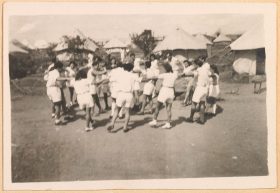
Walter Frankenstein’s group at the internment camp dancing the hora, Famagusta, spring 1947; Jewish Museum Berlin, gift of Leonie and Walter Frankenstein
The passengers of the Latrun didn’t manage to do so one the first attempt. After the ship raised the Israeli flag off of Cyprus, it was boarded by the British when it entered Palestinian waters, and then directed to the harbor at Haifa. But instead of stepping onto land, the passengers had to divide themselves between two British cruisers that brought them to a detention camp on Cyprus. Walter began to cook for a group of 20 people again, and also made an effort to make their free time as pleasant as possible for the men and women.
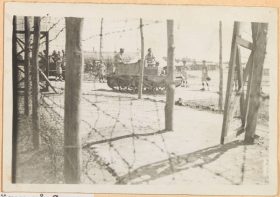
British soldiers patrolling in an internment camp, Famagusta, May 1947; Jewish Museum Berlin, gift of Leonie and Walter Frankenstein
In June of 1947, Walter was finally transferred to the transit camp Atlit in Palestine. He saw his family for the first time after roughly 19 months of separation through the barbed wire fence depicted in the photo. After a brief stay in the Kiryat Shmuel camp, Walter was released in August/September 1947. Finally, he could begin to build a life together with Leonie in Palestine…
Anna Rosemann recommends our Eyewitnesses Talk events series, which will welcome Walter Frankenstein on January 31, 2018.
You can find more photographs from the life of the Frankenstein family in our online collection.
If you would like to delve more deeply into the biographies of Walter and Leonie Frankenstein, we recommend the book Nicht mit uns – Das Leben von Walter und Leonie Frankenstein by Klaus Hillenbrand, which was published in 2008 by the Jüdischer Verlag, an imprint of Suhrkamp.